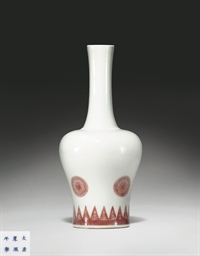A COPPER-RED AND UNDERGLAZE-BLUE MALLET VASEKANGXI MARK AND PERIOD清康熙 青花釉裏紅團花鋸齒紋搖鈴尊 《大清康熙年製》款 the elegant baluster-form body sweeping to high rounded shoulders, with a narrow raised fillet encircling the tall waisted neck, the lower body painted in deep copper-red tones with four evenly spaced medallions, each centering a whorl surrounded by two bands of S-scrolls and thin radiating petals, all above a row of pointed lappets enclosing pairs of C-scrolls and rising from a herringbone border divided by three underglaze-blue lines, the base inscribed with a six-character mark in underglaze blue in three columns Height 9 in., 22.9 cmCondition ReportFor more information on and additional videos for this lot, please contact Cindy.Qi@sothebys.com.Catalogue NoteThis elegant vase denotes the Kangxi Emperor's devotion to Tibetan Buddhism and the innovation of original designs on porcelain during his reign: the swirling three-section gakyil ('Wheel of Joy') that is framed by multiple bands is traditionally the central element of the 'Wheel of the Dharma' dharmachakra, which holds an important place in the Buddhist doctrine. Vases of this type are held in important private and museum collections worldwide; see one illustrated in Kangxi Wares from the Shanghai Museum Collection, Hong Kong, 1998, pl. 7; another published in Porcelains from the Tianjin Municipal Museum, Hong Kong, 1993, pl. 130; and a third vase in the Metropolitan Museum of Art, New York, illustrated together with an underglaze-blue version in Oriental Ceramics. The World's Great Collections, vol. 11, Tokyo, 1982, pl. 119. A similar vase, in the Meiyintang collection, is published in Regina Krahl, Chinese Ceramics from the Meiyintang Collection, vol. 4, part II, London, 2010, pl. 1706 where Krahl notes that the austere design, which is found only on porcelains from the Kangxi reign, may have been inspired by decoration on archaic bronzes.
A COPPER-RED AND UNDERGLAZE-BLUE MALLET VASEKANGXI MARK AND PERIOD清康熙 青花釉裏紅團花鋸齒紋搖鈴尊 《大清康熙年製》款 the elegant baluster-form body sweeping to high rounded shoulders, with a narrow raised fillet encircling the tall waisted neck, the lower body painted in deep copper-red tones with four evenly spaced medallions, each centering a whorl surrounded by two bands of S-scrolls and thin radiating petals, all above a row of pointed lappets enclosing pairs of C-scrolls and rising from a herringbone border divided by three underglaze-blue lines, the base inscribed with a six-character mark in underglaze blue in three columns Height 9 in., 22.9 cmCondition ReportFor more information on and additional videos for this lot, please contact Cindy.Qi@sothebys.com.Catalogue NoteThis elegant vase denotes the Kangxi Emperor's devotion to Tibetan Buddhism and the innovation of original designs on porcelain during his reign: the swirling three-section gakyil ('Wheel of Joy') that is framed by multiple bands is traditionally the central element of the 'Wheel of the Dharma' dharmachakra, which holds an important place in the Buddhist doctrine. Vases of this type are held in important private and museum collections worldwide; see one illustrated in Kangxi Wares from the Shanghai Museum Collection, Hong Kong, 1998, pl. 7; another published in Porcelains from the Tianjin Municipal Museum, Hong Kong, 1993, pl. 130; and a third vase in the Metropolitan Museum of Art, New York, illustrated together with an underglaze-blue version in Oriental Ceramics. The World's Great Collections, vol. 11, Tokyo, 1982, pl. 119. A similar vase, in the Meiyintang collection, is published in Regina Krahl, Chinese Ceramics from the Meiyintang Collection, vol. 4, part II, London, 2010, pl. 1706 where Krahl notes that the austere design, which is found only on porcelains from the Kangxi reign, may have been inspired by decoration on archaic bronzes.













.jpg)

Try LotSearch and its premium features for 7 days - without any costs!
Be notified automatically about new items in upcoming auctions.
Create an alert